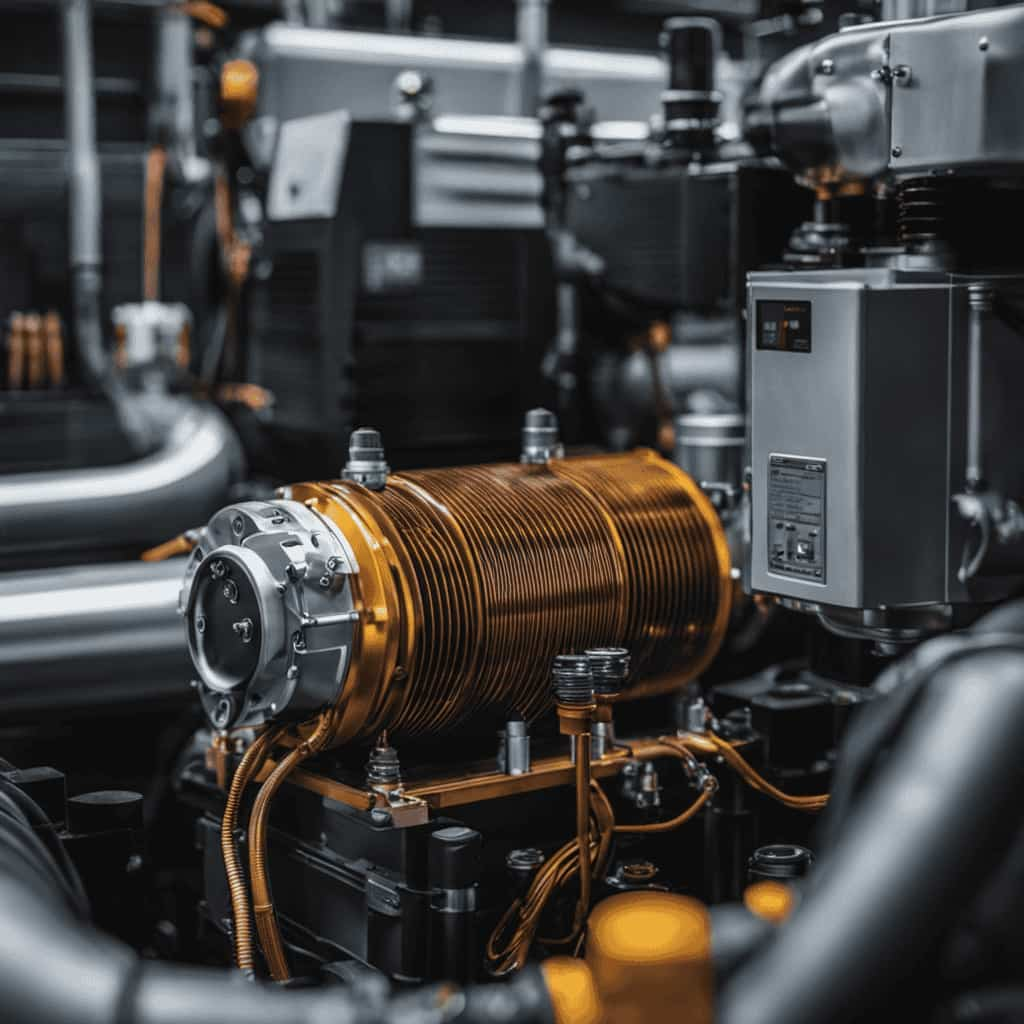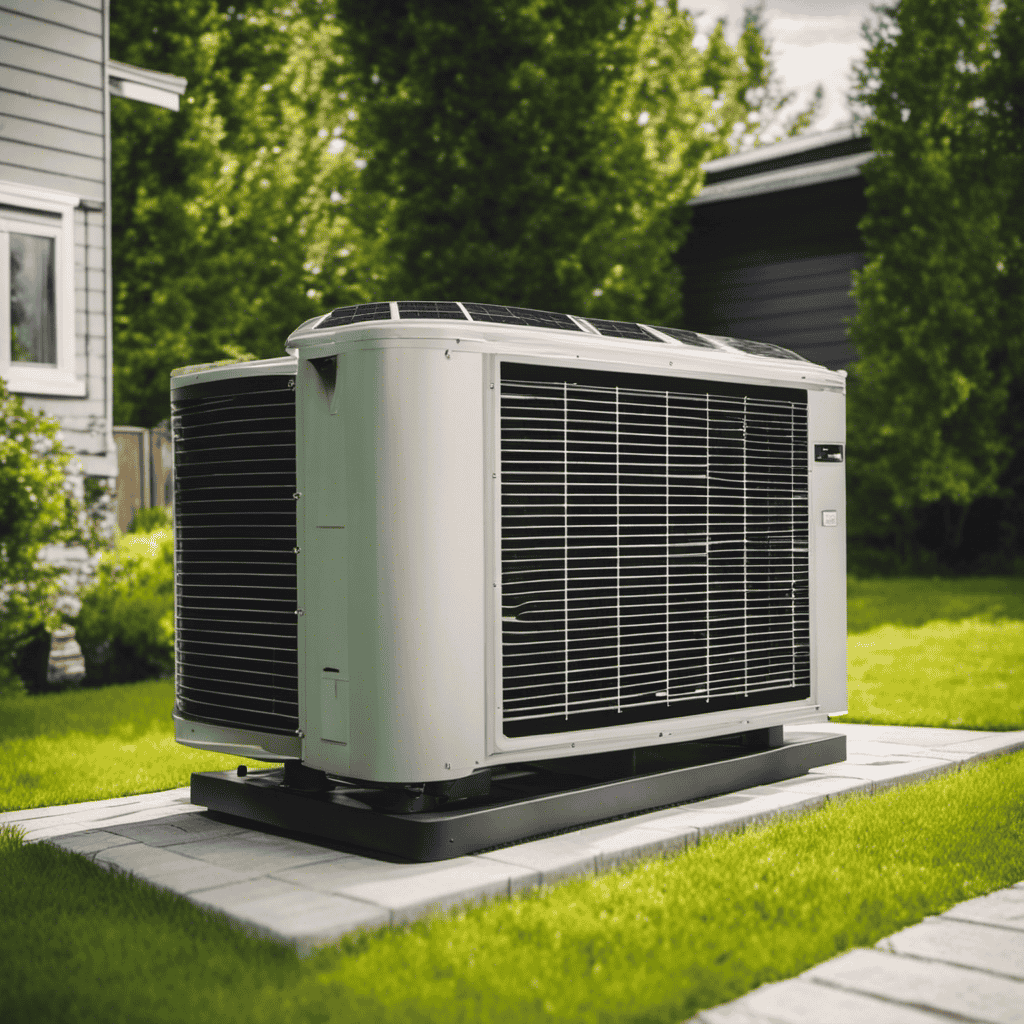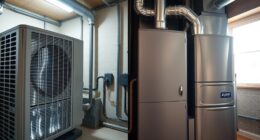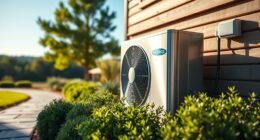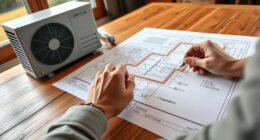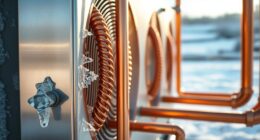Did you know that optimizing your heat pump can lead to significant energy savings?
In this article, we’ll share some valuable tips to help you make the most of your electricity usage.
From understanding efficiency ratings to implementing thermostat settings for maximum energy savings, we’ve got you covered.
By following these simple steps, you can enhance the performance of your heat pump and enjoy greater efficiency while maintaining your freedom to use electricity as you please.

Key Takeaways
- Proper sizing of the heat pump is crucial for optimal performance and energy efficiency.
- Optimal thermostat settings, including temperature setbacks and scheduling, can lead to energy savings.
- Regular maintenance and cleaning improve heat pump efficiency and extend its lifespan.
- Strategic coordination of auxiliary heating systems and setting temperature thresholds can maximize energy efficiency and minimize costs.
Understanding Heat Pump Efficiency Ratings
Let’s delve into understanding heat pump efficiency ratings and how they can help us optimize our electricity usage.
Heat pump energy consumption refers to the amount of electricity that a heat pump uses to provide heating or cooling for a space. It’s important to consider the efficiency of a heat pump when choosing one for your home.
There are several factors that can affect heat pump efficiency. One of the main factors is the size of the heat pump in relation to the space it’s intended to heat or cool. A heat pump that’s too small may struggle to reach the desired temperature, while a heat pump that’s too large may cycle on and off frequently, wasting energy.
Other factors that can affect efficiency include the insulation of the space, the outdoor temperature, and the quality of the installation.

Proper Sizing of Heat Pumps for Optimal Performance
Our goal is to ensure optimal performance by properly sizing our heat pumps. When it comes to heat pump installation, choosing the right size is crucial for energy efficient home design.
A heat pump that’s too small may struggle to adequately heat or cool our living spaces, resulting in decreased efficiency and increased energy consumption. On the other hand, a heat pump that’s too large may cycle on and off frequently, wasting energy and potentially shortening its lifespan.
To determine the appropriate size, it’s important to consider factors such as the climate, insulation levels, and the size and layout of our home. By selecting the right size for our heat pump, we can maximize its efficiency and ensure optimal performance for years to come.
Now, let’s explore how implementing thermostat settings can further enhance our energy savings.

Implementing Thermostat Settings for Energy Savings
We can achieve energy savings by implementing optimal thermostat settings. By utilizing smart thermostat technology and taking advantage of programmable thermostat benefits, we can maximize efficiency and reduce energy consumption. Here are four tips to help you implement thermostat settings for energy savings:
-
Set temperature setbacks: Lower the temperature when you’re away from home or asleep to reduce energy usage.
-
Utilize scheduling features: Program your thermostat to automatically adjust temperatures based on your daily routine.
-
Take advantage of remote access: Use smart thermostat technology to control your thermostat remotely, allowing you to make adjustments even when you’re not at home.

-
Consider zone heating and cooling: Divide your home into different zones and control the temperature in each zone separately, ensuring that you’re only heating or cooling the areas that are in use.
Regular Maintenance and Cleaning for Improved Efficiency
Regular maintenance and cleaning are essential for improving the efficiency of your heat pump. By regularly maintaining and cleaning your heat pump, you can ensure that it operates at its peak performance, saving you energy and money in the long run. Here are some maintenance benefits and cleaning techniques that can help optimize your heat pump’s efficiency:
| Maintenance Benefits | Cleaning Techniques |
|---|---|
| 1. Extended lifespan | 1. Clean or replace filters regularly |
| 2. Improved energy efficiency | 2. Clear debris from outdoor unit |
| 3. Enhanced indoor air quality | 3. Clean evaporator and condenser coils |
| 4. Reduced risk of breakdowns | 4. Check and tighten electrical connections |
| 5. Cost savings on repairs | 5. Schedule professional maintenance annually |
Regular maintenance and cleaning not only improve the efficiency of your heat pump but also contribute to its longevity and overall performance. By following these simple maintenance and cleaning techniques, you can ensure that your heat pump operates optimally, providing you with efficient heating and cooling throughout the year.
Utilizing Heat Pump Auxiliary Heating Systems Strategically
To optimize the utilization of heat pump auxiliary heating systems, it’s important to strategically plan and coordinate their operation with the primary heat pump. By doing so, you can maximize energy efficiency and minimize costs.

Here are some tips to help you utilize heat pump auxiliary heating systems strategically:
-
Ensure proper insulation: Insulate your heat pump and its auxiliary heating systems to prevent heat loss and improve overall efficiency.
-
Choose energy-efficient heat pump models: Invest in energy-efficient heat pump models that have a high coefficient of performance (COP) to ensure optimal performance and reduced energy consumption.
-
Set temperature thresholds: Set temperature thresholds for when the auxiliary heating systems should kick in. This will prevent unnecessary operation and save energy.

-
Utilize programmable thermostats: Use programmable thermostats to schedule the operation of auxiliary heating systems based on your specific heating needs and lifestyle.
Frequently Asked Questions
Can a Heat Pump Be Used for Both Heating and Cooling Purposes?
Yes, a heat pump can be used for both heating and cooling purposes. It offers several advantages such as energy efficiency and cost savings. The installation process involves connecting the heat pump to the indoor and outdoor units.
Are There Any Government Incentives or Rebates Available for Installing a Heat Pump?
Yes, there are government incentives and energy rebates available for installing a heat pump. These incentives can help offset the cost of installation and encourage more efficient electricity usage.
How Long Does a Heat Pump Typically Last Before Needing to Be Replaced?
Heat pumps typically last around 15-20 years before needing to be replaced. Signs of deterioration include increased energy consumption, reduced heating/cooling capacity, and frequent repairs. Regular maintenance can help extend the lifespan.

Can a Heat Pump Be Used in Extremely Cold Climates?
Yes, a heat pump can be used in extremely cold climates. Although heat pump efficiency may decrease in low temperatures, there are models designed to handle extreme cold. However, it’s important to consider heat pump installation costs.
Are There Any Specific Precautions or Safety Measures to Consider When Using a Heat Pump?
When using a heat pump, it’s important to take precautions and follow safety measures to ensure efficient and safe operation. Regular maintenance, proper installation, and avoiding DIY repairs are some key considerations.
Conclusion
In conclusion, by understanding heat pump efficiency ratings, properly sizing the unit, implementing energy-saving thermostat settings, regularly maintaining and cleaning the system, and strategically utilizing auxiliary heating systems, you can optimize the performance and efficiency of your heat pump.
This won’t only save you energy and money, but also ensure a comfortable and cozy home environment.

So, take these tips to heart and start maximizing your electricity usage today.




